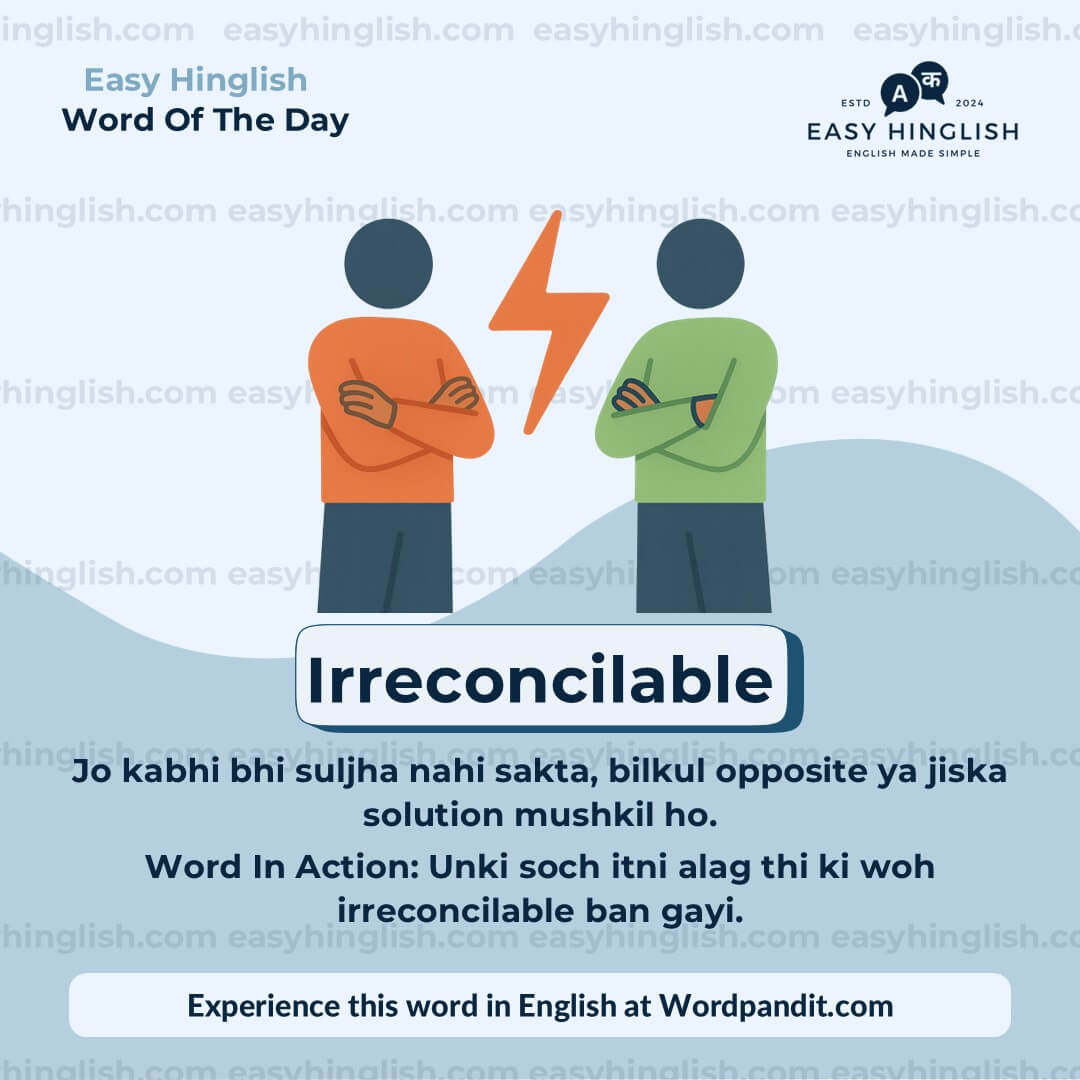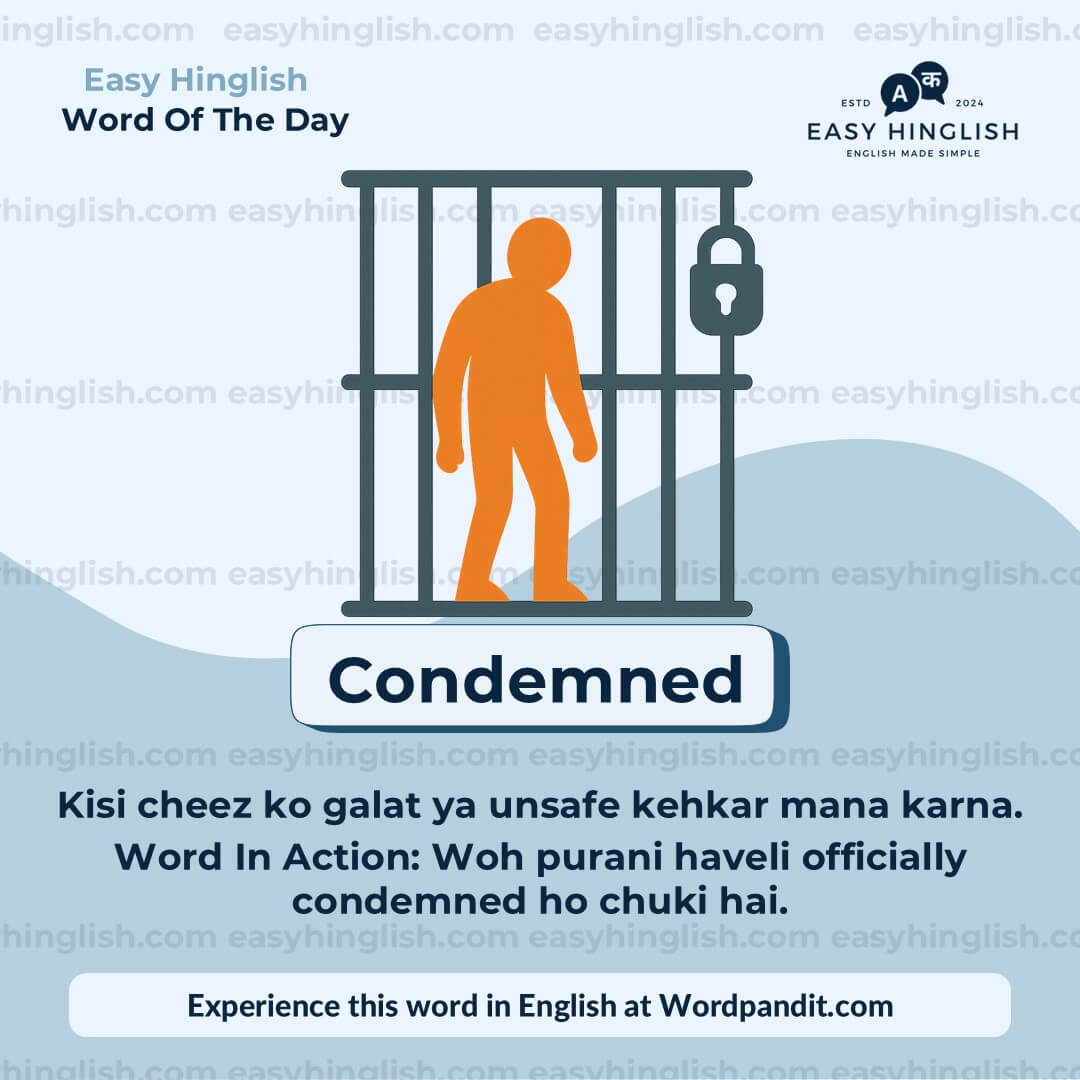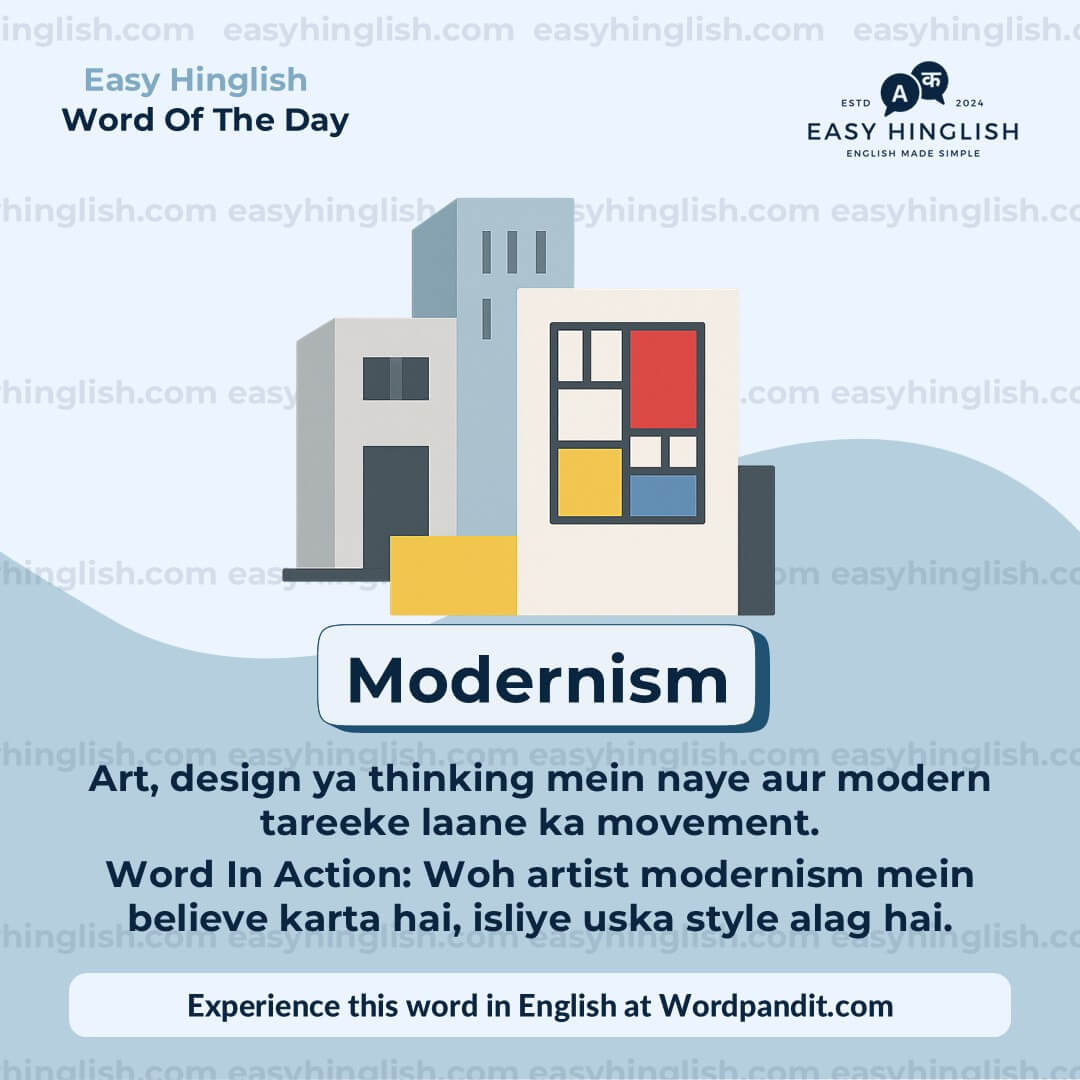Daily Vocabulary International Newspapers aur Publications se Seekho
Wordpandit ke Global Vocabulary Hub ke Saath Apni Vocabulary Expand Karo
Wordpandit par, hum aapko ek truly global vocabulary develop karne me madad karte hain, jo duniya ke sabse respected international publications se li gayi hoti hai. Yeh section aapko naye words se introduce karne ke liye design kiya gaya hai jo global conversations aur trends ko define karte hain.
Global Sources ka Power
Aapko globally sochne aur communicate karne me madad dene ke liye, hum vocabulary curate karte hain world ke top international sources se, jaise:
- The New York Times
- The Washington Post
- BBC
- The Guardian
- The Economist
- Scientific American
- Psychology Today
- Aur bhi bahut saare...
Globally Socho, Competitively Seekho
Hamare daily updates se aap international publications ke naye words seekhoge jo global news aur developments se jude hote hain. Isse aapki vocabulary current bhi rahegi aur globally relevant bhi.
Apni Global Soch Ko Expand Karo
Agar aap international exams ki tayari kar rahe ho, global business communication me excel karna chahte ho, ya sirf apni language skills improve karna chahte ho, toh Wordpandit aapko global level pe grow karne ke liye best resources provide karta hai.
Smart Learning, Global Reach
Hamari learning methodology me global examples, memory aids, aur interactive activities shamil hain, jo naye words ko effectively yaad karne aur real-world me use karne me madad karti hain.
Aaj Hi Apni Global Vocabulary Journey Shuru Karo!
Wordpandit Kyun Choose Karein?
Practical Learning: Aise words seekho jo real-world reading aur communication me aapko sach me kaam aayenge, taaki aapki comprehension aur bolne ki skills improve ho.
Diverse Content: Current affairs se lekar scientific breakthroughs tak, hamare different sources aapko multiple domains ki vocabulary seekhne ka moka dete hain.
Effortless Integration: Wordpandit ko apni daily routine ka part banao. Sirf kuch minute har din dene se aapki vocabulary time ke saath kaafi improve ho sakti hai.
Vocabulary Mastery Tak Ka Aapka Safar
- Regularly hamare Daily Vocabulary section ko visit karo
- Naye words explore karo aur unka context me use samjho
- In words ko apni writing aur bolne ki practice me use karne ki koshish karo
- Jaise-jaise aapke words badhte hain, apni progress ko track karo
Aaj Hi Apni Vocabulary Journey Shuru Karo!
Wordpandit ke saath vocabulary improve karna start karo. Roz thoda effort dalne se aap ek strong vocabulary develop kar sakte ho jo academic, professional, aur personal life me kaafi kaam aayegi.
Yaad rakho, ek naya shabd roz seekhna linguistic limitations ko door karne ka best tareeka hai! Wordpandit ko apni daily learning journey ka sathi banao aur vocabulary excellence ki taraf badho!
WORD-1: Irreconcilable
Sandarbh (Context):
"Jab maine Mr. Yoon ki failed attempt ke din baad apne parents ko call kiya, tab woh irreconcilable national divide mere harmonious family mein bhi evident tha: maine us blatantly undemocratic power grab ki condemn ki, jo past military rule ki grim memories revive karti thi; mere father ne ise necessary bataya opposition ko rein in karne ke liye, jo unki nazar mein pro-North Korea hai." - The New York Times
Vyakhya (Explanatory Paragraph):
Irreconcilable ka matlab hai 'aisi differences ya conflicts jo itni fundamental hain ki unhe resolve karna ya harmonize karna impossible hai.' Yeh word tab use hota hai jab do viewpoints, ideologies, ya positions itne opposite hote hain ki koi compromise ya agreement possible nahi hota. Irreconcilable ko formal writing, newspaper editorials, political commentary aur competitive exam passages mein use karte hain jab deep divisions describe karne ho—chahe relationships mein, ideologies mein, families mein ya nations mein—jo negotiation ya understanding se bridge nahi ho sakte.
Arth (Meaning): Aisi cheezein jo resolve ya compatible nahi ban sakti; fundamentally incompatible (Adjective)
Uccharan (Pronunciation): ih-REK-uhn-SYE-luh-buhl (इरेकन्साइलबल)
Kathinai Star (Difficulty Level): ⭐⭐⭐ Intermediate se Advanced
Utpatti (Etymology): Irreconcilable prefix 'ir-' (jiska matlab hai 'nahi') aur 'reconcilable' ke combination se bana hai, jo Latin 'reconciliare' se aaya hai jiska matlab hai 'dobara saath lana.' Yeh word 16th century mein English mein aaya differences ko describe karne ke liye jo itne profound hain ki woh harmony mein wapis nahi laye ja sakte, chahe kitni bhi koshish kyun na ki jaye. Time ke saath, yeh particularly common ho gaya ideological, political aur personal conflicts describe karne mein jo resolution ki saari koshishon ko resist karte hain.
Prashant Sir Ke Tathya (Prashant Sir's Notes):
Bahut students irreconcilable ko 'incompatible' se confuse karte hain—dono ka matlab hai ki cheezein saath kaam nahi karti, lekin irreconcilable aur incompatible mein kya farak hai yeh samajhna crucial hai: irreconcilable specifically emphasize karta hai ki conflict koshish ke baad bhi resolve nahi ho sakta, jabki incompatible ka simple matlab hai ki cheezein fit nahi hoti. CAT aur GRE ke students ke liye, irreconcilable aksar Reading Comprehension passages mein dikhta hai political divisions, philosophical debates ya relationship breakdowns ke baare mein. Indian newspapers jaise The Hindu aur Indian Express mein aapko aksar 'irreconcilable differences' milega political analysis mein—especially coalition government disputes ya BJP-Congress ideological clashes describe karte waqt. Irreconcilable ka sahi istemal kaise karein: typical pattern hai 'irreconcilable differences/views/positions' followed by description ki unhe impossible kyun hai resolve karna.
Samanarthi & Vipritarthi (Synonyms & Antonyms):
Samanarthi (Synonyms): incompatible, conflicting, contradictory, opposing, clashing, incongruous, discordant, mutually exclusive, antagonistic, mel na khane wala
Vipritarthi (Antonyms): compatible, harmonious, reconcilable, agreeable, resolvable, consonant, mel khana
Udaharan (Usage Examples):
- Coalition partners ke beech farm loan waivers par irreconcilable differences ki wajah se finally Karnataka mein government collapse ho gayi.
- Priya aur Arjun ki shaadi years ke irreconcilable views ke baad end hui settle hone ko lekar—woh Mumbai chahti thi, woh Bangalore par insist kar raha tha.
- Supreme Court ne Aadhaar case mein individual privacy rights aur national security concerns ke beech irreconcilable conflict note kiya.
- Multiple mediation attempts ke bawajood, business partners ki startup ke future ke liye irreconcilable visions thi aur unhone amicably part ways lene ka decide kiya.
Sanskritik Sandarbh (Cultural Reference):
"Kabhi Alvida Naa Kehna mein, Shah Rukh Khan aur Rani Mukerji ke characters apni respective marriages mein irreconcilable differences discover karte hain, jo unhe ek dusre ki taraf le jaati hain—ek Bollywood exploration ki jab love fundamental incompatibilities ko bridge nahi kar sakta." - Film analysis
Sochiye (Think About It):
Kya India mein political differences increasingly irreconcilable hote ja rahe hain, ya phir hum mein sirf patience aur dialogue ki kami hai jo hamare divides ko bridge kar sake?
Chhoti Kriya (Quick Activity):
Indian public life mein teen areas identify karein jahan aapko irreconcilable differences dikhte hain—politics, religion, ya regional disputes. Har conflict ke liye ek sentence likhein explaining ki aapko kyun lagta hai ki woh impossible hai resolve karna.
Yaad Karne Ka Tarika (Memory Tip):
Irreconcilable ko aise yaad rakhein: 'IR (not) + RECONCILE + ABLE'—imagine karo India vs Pakistan cricket rivalry jahan fans itne passionate hain ki unki differences NOT able to be RECONCILED hain, chahe kitne bhi peace talks ho. 'IR' prefix immediately batata hai: yeh fix nahi ho sakta.
Vastavik Jeevan Me Upyog (Real-World Application):
Irreconcilable commonly legal documents mein use hota hai (especially divorce petitions mein 'irreconcilable differences' cite karte waqt), political commentary mein coalition breakdowns analyze karte waqt, business reports mein partnership dissolutions explain karte waqt, aur editorial pieces mein ideological divides discuss karte waqt. UPSC ya CAT ke liye competitive exam essays mein, 'irreconcilable' use karna sophisticated vocabulary demonstrate karta hai jab conflicts discuss kar rahe ho—chahe India-China border disputes analyze kar rahe ho, caste-based social divisions, ya environmental vs development priorities. Journalists iska use karte hain signal dene ke liye ki compromise impossible hai, jo readers ko division ki severity samajhne mein help karta hai.
WORD-2: Condemned
Sandarbh (Context):
"Jab maine Mr. Yoon ki failed attempt ke din baad apne parents ko call kiya, tab woh irreconcilable national divide mere harmonious family mein bhi evident tha: maine us blatantly undemocratic power grab ko condemned kiya, jo past military rule ki grim memories revive karti thi; mere father ne ise necessary bataya opposition ko rein in karne ke liye, jo unki nazar mein pro-North Korea hai." - The New York Times
Vyakhya (Explanatory Paragraph):
Condemned ka matlab hai 'kisi cheez ki strong disapproval express karna ya use wrong ya evil declare karna.' Yeh word tab use hota hai jab koi publicly actions, policies, ya behaviors ko criticize karta hai jo unhe morally ya ethically unacceptable lagte hain. Condemned commonly news reports, political speeches, international diplomacy aur competitive exam passages mein use hota hai CAT, GRE aur UPSC ke liye jab wrongdoing, violence, injustice ya controversial decisions ki formal denunciation describe karni ho. Yeh word moral judgment aur serious disapproval ka tone carry karta hai.
Arth (Meaning): Kisi cheez ki complete disapproval express karna; severely criticize karna; galat declare karna (Verb - past tense)
Uccharan (Pronunciation): kuhn-DEMD (कन्डेम्ड)
Kathinai Star (Difficulty Level): ⭐⭐ Basic se Intermediate
Utpatti (Etymology): Condemned Latin 'condemnare' se aaya hai, jo 'com-' (intensive prefix) aur 'damnare' (jiska matlab hai 'loss inflict karna ya doom karna') ko combine karta hai. Yeh word 14th century mein Old French 'condemner' ke through English mein aaya. Originally legal contexts mein guilt pronounce karne ya sentence dene ke liye use hota tha, lekin evolve karke strong moral disapproval express karne ka matlab ban gaya. Word apni heavy, final quality retain karta hai—jab aap kisi cheez ko condemn karte ho, aap ek severe judgment pass kar rahe hote ho jo approval ke liye koi room nahi chhodta.
Prashant Sir Ke Tathya (Prashant Sir's Notes):
Students aksar poochhte hain: condemned aur criticized mein kya farak hai? Dono disapproval dikhate hain, lekin condemned kaafi zyada strong hai—yeh moral judgment aur complete rejection imply karta hai, jabki criticized constructive ya mild ho sakta hai. Condemned ka sahi istemal kaise karein sentences mein: yeh typically serious issues jaise violence, injustice, ya human rights violations ke saath appear hota hai. UPSC aur CAT ke students ke liye, condemned aksar passages mein dikhta hai international relations ke baare mein, jahan countries terrorist attacks ko condemn karti hain, ya editorials mein jahan activists government policies ko condemn karte hain. Indian English newspapers mein aapko patterns milenge jaise 'opposition condemned the government's decision' ya 'activists condemned the police action'—yeh word signal karta hai na sirf disagreement balki moral outrage. Yaad rakhein: aap actions ko condemn karte ho, sirf dislike nahi karte.
Samanarthi & Vipritarthi (Synonyms & Antonyms):
Samanarthi (Synonyms): denounced, censured, criticized severely, disapproved, decried, repudiated, castigated, vilified, damned, ninda ki
Vipritarthi (Antonyms): praised, approved, commended, endorsed, applauded, lauded, supported, taarif ki
Udaharan (Usage Examples):
- Opposition parties ne 2016 mein government ki sudden demonetization move ko condemned kiya, ise poorly planned aur small businesses ke liye devastating batate hue.
- United Nations ne Mumbai mein terrorist attack ko condemned kiya, India ke saath solidarity express karte hue aur perpetrators ko harbor karne walon se accountability demand karte hue.
- Human rights organizations ne Rohingya refugees ke against violence ko condemned kiya, vulnerable communities ko protect karne ke liye international intervention ka urge karte hue.
- Virat Kohli ne India ki cricket loss ke baad Mohammed Shami ki online trolling ko publicly condemned kiya, fans ke beech respect aur unity ke liye call karte hue.
Sanskritik Sandarbh (Cultural Reference):
"Film Article 15 mein, Ayushmann Khurrana ka character caste-based discrimination aur violence ko condemn karta hai jo woh ek police officer ke roop mein witness karta hai, jo social injustice ke against ek powerful statement banata hai aur India bhar mein audiences ke saath resonate karta hai." - Film commentary
Sochiye (Think About It):
Jab political leaders publicly actions ko condemn karte hain lekin concrete steps lene mein fail ho jate hain, kya condemnation apna meaning kho deta hai aur sirf performative ban jata hai?
Chhoti Kriya (Quick Activity):
Aaj ke Indian newspapers se do news headlines dhoondhein jahan kisi ne ya kisi organization ne kisi action ko condemned kiya ho. Notice karein ki 'condemned' word ke saath kaunse specific language patterns appear hote hain.
Yaad Karne Ka Tarika (Memory Tip):
Condemned ko aise yaad rakhein: 'CON (against) + DEMNED (damned)'—imagine karo ek cricket match jahan pura stadium umpire ke decision ke AGAINST hai aur sab use loudly DAMN kar rahe hain. Jab aap kisi cheez ko condemn karte ho, aap uske totally against hote ho strong moral disapproval ke saath, jaise crowd unanimously ek bad call ko reject kar rahi ho.
Vastavik Jeevan Me Upyog (Real-World Application):
Condemned extensively journalism mein use hota hai, particularly international relations, political statements, aur social issues report karte waqt. News agencies iska use karte hain jab countries terrorism, violence, ya policy decisions ke against formal statements issue karti hain. Diplomatic communication mein, governments un actions ko condemn karti hain jo international law ya human rights ko violate karte hain. UPSC aspirants ke liye governance, ethics, ya international relations par essays likhte waqt, 'condemned' ka appropriate use strong disapproval ki understanding demonstrate karta hai. Corporate contexts mein, companies unethical practices ya discrimination ko condemn karti hain. Yeh word sirf disagreement nahi balki ek moral stance signal karta hai, jo ise persuasive writing aur formal criticism mein powerful banata hai.
WORD-3: Grim
Sandarbh (Context):
"Jab maine Mr. Yoon ki failed attempt ke din baad apne parents ko call kiya, tab woh irreconcilable national divide mere harmonious family mein bhi evident tha: maine us blatantly undemocratic power grab ko condemned kiya, jo past military rule ki grim memories revive karti thi; mere father ne ise necessary bataya opposition ko rein in karne ke liye, jo unki nazar mein pro-North Korea hai." - The New York Times
Vyakhya (Explanatory Paragraph):
Grim ka matlab hai 'harsh, forbidding ya depressing; koi cheez jo unpleasant ya worrying ho.' Yeh word tab use hota hai jab situations, expressions, outlooks, ya memories describe karni ho jo dark, serious, ya hardship aur suffering se bhari hain. Grim ka upyog kab hota hai: yeh commonly news reports mein dikhta hai economic downturns, war, disasters, ya difficult historical periods ke baare mein, aur frequently CAT, GRE, aur UPSC reading comprehension passages mein appear hota hai bleakness ya severity convey karne ke liye. Yeh word ek hi powerful adjective mein literal darkness aur metaphorical hopelessness dono capture karta hai.
Arth (Meaning): Harsh, forbidding ya depressing; bahut serious ya worrying dikhayi ya sunai dena (Visheshan/Adjective)
Uccharan (Pronunciation): GRIM (ग्रिम)
Kathinai Star (Difficulty Level): ⭐⭐ Basic se Intermediate
Utpatti (Etymology): Grim Old English 'grimm' se aaya hai jiska matlab hai 'fierce, cruel, ya savage,' jo Old Norse aur German languages ke similar words se related hai. Is word ki ancient Germanic roots hain jo battle mein pehne jane wale masks aur death imagery se connect hain. Centuries ke saath, grim fierce warriors ya cruel actions describe karne se evolve hua aur ab kisi bhi harsh, depressing, ya foreboding situation ko encompass karta hai. Word ki short, sharp sound perfectly uske meaning se match karti hai—sirf ek syllable jo harsh reality ke weight ke saath hit karta hai.
Prashant Sir Ke Tathya (Prashant Sir's Notes):
Bahut students grim ko 'gloomy' se confuse karte hain—dono negativity describe karte hain, lekin grim aur gloomy mein farak samajhna important hai: grim harshness aur severity emphasize karta hai, aksar life-or-death seriousness ke saath, jabki gloomy ka simple matlab hai sad ya dark. CAT aur GRE reading comprehension ke liye, grim aksar passages mein dikhta hai economic crises, wars, ya historical tragedies ke baare mein—jab aap 'grim reality' ya 'grim prospects' dekhte ho, author truly serious problems signal kar raha hota hai, sirf temporary sadness nahi. Indian newspapers jaise The Hindu mein, aapko phrases milenge jaise 'grim employment scenario' ya 'grim monsoon forecast'—yeh sirf negative predictions nahi hain balki severe consequences ki warnings hain. Grim ka sahi istemal kaise karein: yeh word aksar 'reality,' 'situation,' 'outlook,' 'reminder,' ya 'memories' ke saath pair hota hai jo describe ki ja rahi cheez ki seriousness emphasize karne ke liye.
Samanarthi & Vipritarthi (Synonyms & Antonyms):
Samanarthi (Synonyms): harsh, bleak, forbidding, somber, stern, severe, depressing, dreary, dismal, dire, ominous, bhayanak, kathor
Vipritarthi (Antonyms): cheerful, pleasant, bright, hopeful, optimistic, encouraging, joyful, khushhal
Udaharan (Usage Examples):
- Economic survey ne India ke rural employment crisis ki ek grim picture paint ki, jahan millions farmers apne ends meet karne ke liye struggle kar rahe hain.
- Partition survivors 1947 ki grim memories carry karte hain—violence aur displacement ki stories jo generations baad bhi families ko haunt karti hain.
- Doctor ne compassion ke saath grim news deliver ki, explain karte hue ki Rajesh ke father ke paas aggressive treatment ke bawajood sirf months bache hain.
- Diwali week mein Mumbai ki air quality report grim reading thi, pollution levels hazardous categories mein poore city mein pahunch gaye the.
Sanskritik Sandarbh (Cultural Reference):
"Film Rang De Basanti mein, government corruption aur injustice ki grim reality carefree college students ko revolutionaries mein transform karti hai—unki youthful energy aur jo grim circumstances woh face karte hain uske beech ka contrast puri narrative ko drive karta hai." - Film analysis
Sochiye (Think About It):
Leaders unemployment, poverty, ya climate change ke baare mein grim realities ko acknowledge karne se aksar kyun avoid karte hain, jab data clearly in problems ki severity dikhata hai?
Chhoti Kriya (Quick Activity):
Indian society ya politics mein teen situations list karein jinhe 'grim' describe kiya ja sakta hai. Har ek ke liye ek sentence likhein jo explain kare ki situation ko harsh ya severe kya banata hai sirf unfortunate hone ki jagah.
Yaad Karne Ka Tarika (Memory Tip):
Grim ko aise yaad rakhein: 'GRIM REAPER'—death ki woh figure, black mein wrapped, sabse harsh reality represent karta hai. Bilkul jaise Virat Kohli ka grim expression India ke World Cup final haarने के baad—sirf sad nahi balki intensely serious aur harsh. Yeh word utna hi short aur sharp hai jitni reality jo yeh describe karta hai: koi softness nahi, sirf hard truth.
Vastavik Jeevan Me Upyog (Real-World Application):
Grim extensively journalism mein use hota hai, particularly economic reports, disaster coverage, aur serious social issues ke analysis mein. Business newspapers phrases use karti hain jaise 'grim quarterly results' ya 'grim jobs data' genuinely troubling trends signal karne ke liye jo normal fluctuations se beyond hain. UPSC essay writing mein, grim ka appropriate use poverty, unemployment, ya environmental degradation discuss karte waqt precise vocabulary demonstrate karta hai—yeh examiners ko batata hai ki aap issues ki severity samajhte ho. Medical professionals grim use karte hain serious diagnoses deliver karte waqt. Editorial writers iska employ karte hain optimistic spin cut through karne aur harsh realities present karne ke liye. Yeh word formal communication mein reality check ki tarah kaam karta hai, signal karte hue ki sugarcoating inappropriate hogi.
WORD-4: Aesthetics
Sandarbh (Context):
"Arts mein, aesthetics ko strangely devalue kiya jata hai. European academic art ke conventions ke reaction mein, Modernism (late 19th c se mid-20th) ne is idea ke against rebel kiya ki art 'beautiful' honi chahiye. Jab mujhe art school mein discover hua ki beauty beside the point thi, main delighted thi ugly things banana!" - Psychology Today
Vyakhya (Explanatory Paragraph):
Aesthetics ka matlab hai 'beauty aur artistic taste se deal karne wali philosophy ki branch; kisi cheez ka visual appearance ya style.' Yeh word tab use hota hai jab discuss karna ho ki koi cheez dekhne mein pleasing kyun lagti hai, art aur design mein beauty ke principles kya hain, ya objects aur spaces ki overall visual appeal kaisi hai. Aesthetics frequently art criticism, design discussions, philosophy texts aur competitive exam passages mein appear hota hai CAT, GRE, aur UPSC ke liye, especially culture, architecture, aur artistic movements ke baare mein questions mein. Aesthetics kaise use karte hain yeh samajhna classical beauty aur modern design principles dono ko analyze karne mein help karta hai.
Arth (Meaning): Beauty ki study ya philosophy; kisi cheez ka visual appearance ya style (Sangya/Noun); adjective ke roop mein bhi: aesthetic
Uccharan (Pronunciation): es-THET-iks (ya ees-THET-iks) (एस्थेटिक्स)
Kathinai Star (Difficulty Level): ⭐⭐⭐ Intermediate
Utpatti (Etymology): Aesthetics Greek 'aisthetikos' se aaya hai jiska matlab hai 'senses ke through perception se related,' jo 'aistheta' se derive hua hai jiska matlab hai 'perceptible things.' Yeh term German philosopher Alexander Baumgarten ne 1735 mein coin kiya tha sensory perception aur beauty ki science describe karne ke liye. Yeh 18th century ke late mein English mein aaya jab art aur philosophy ki discussions ho rahi thi. Word initially beauty ke philosophical questions par focus karta tha, lekin evolve karke visual appeal, style, aur artistic judgment ke saare aspects encompass karne laga, jo ise aaj art, design, architecture, aur social media culture mein essential vocabulary banata hai.
Prashant Sir Ke Tathya (Prashant Sir's Notes):
Students aksar 'aesthetics' ko 'cosmetics' se confuse karte hain—dono appearance se related hain, lekin aesthetics aur cosmetics mein farak fundamental hai: aesthetics beauty ki philosophy aur principles ke baare mein hai across all visual experiences, jabki cosmetics specifically makeup products hain. CAT aur GRE aspirants ke liye, aesthetics aksar reading comprehension passages mein dikhta hai art movements, architectural theory, ya cultural criticism ke baare mein. Indian English usage mein, aap log bolte hain 'the aesthetics of this cafe' ya 'Instagram aesthetics'—overall visual vibe ya style ko refer karte hue. Aesthetics ka sahi istemal kaise karein sentences mein: singular noun ke roop mein jab field discuss kar rahe ho ('Aesthetics is important in design') ya plural jab visual qualities discuss kar rahe ho ('The aesthetics of Mughal architecture are stunning'). UPSC essays mein culture ya heritage par, aesthetics ki understanding demonstrate karna sophisticated thinking dikhata hai ki hum certain art forms ya architectural styles ko kyun value karte hain.
Samanarthi & Vipritarthi (Synonyms & Antonyms):
Samanarthi (Synonyms): visual appeal, artistic taste, beauty, style, design principles, artistic philosophy, visual harmony, artistry, elegance, sundarata
Vipritarthi (Antonyms): ugliness, unattractiveness, functionality (jab contrast ho), practicality (jab beauty ke opposed ho), plainness, badsoorati
Udaharan (Usage Examples):
- Delhi Airport ka naya Terminal 3 traditional Indian aesthetics ko modern architectural functionality ke saath balance karta hai, poore space mein lotus-inspired designs incorporate karte hue.
- Minimalist aesthetics ne Indian urban homes ko take over kar liya hai, young professionals clean lines prefer karte hain unke parents ki favored ornate furniture ke comparison mein.
- Sabyasachi ki bridal collections vintage Bollywood aesthetics ko traditional Bengali weaving techniques ke saath blend karti hain, ek distinctive visual style create karte hue jo luxury weddings define karti hai.
- Café ki Instagram-worthy aesthetics—pastel walls, hanging plants, aur marble tables—uski overpriced coffee se zyada customers attract karti hain actually deserve karne se.
Sanskritik Sandarbh (Cultural Reference):
"Wes Anderson films jaise The Grand Budapest Hotel apni distinctive aesthetics ke liye celebrate ki jaati hain—symmetrical compositions, pastel color palettes, aur meticulous production design jo instantly recognizable visual worlds create karte hain." - Film criticism
Sochiye (Think About It):
Kya social media ka 'aesthetics' obsession—perfectly curated Instagram feeds aur Pinterest boards—ne humein appearance ko substance se zyada value karna sikha diya hai, ya simply beauty aur design ke baare mein discussions ko democratize kiya hai?
Chhoti Kriya (Quick Activity):
Koi bhi do jagah choose karein jo aap regularly visit karte ho—ek café, aapka college campus, ya metro station. Do sentences likhein unki aesthetics compare karte hue: har space ki style aur appeal ko kaunse visual elements define karte hain?
Yaad Karne Ka Tarika (Memory Tip):
Aesthetics ko tod ke dekho: 'A-SEAT-TICS'—imagine karo ek beautifully designed space mein A SEAT lete hue aur excitement se TICS (twitches) aa rahe hain ki kitna gorgeous sab kuch dikh raha hai! Ya yaad rakho: Shah Rukh Khan ka ghar Mannat stunning aesthetics rakhta hai—har photo carefully curated beauty aur style dikhati hai. Yeh word beauty ki philosophy aur space ki visual vibe dono capture karta hai.
Vastavik Jeevan Me Upyog (Real-World Application):
Aesthetics multiple professional fields mein crucial vocabulary hai. Interior designers clients ko concepts present karte waqt 'residential aesthetics' discuss karte hain. Fashion journalists fashion weeks mein 'aesthetics of couture collections' analyze karti hain. Architects 'sustainable aesthetics' ke baare mein likhte hain jo environmental concerns ko visual appeal ke saath balance kare. Digital marketing mein, teams social media presence ke liye 'brand aesthetics' ke baare mein strategize karti hain. UPSC aspirants ke liye Indian culture par essays likhte waqt, temple architecture, classical dance forms, ya traditional crafts ki aesthetics discuss karna sophisticated cultural understanding demonstrate karta hai. Yeh term philosophy, art, design, aur everyday conversations ko bridge karta hai ki cheezein jo tarah dikhti hain waise kyun dikhti hain aur visual appeal hamare lives mein kyun matter karta hai.
WORD-5: Modernism
Sandarbh (Context):
"Arts mein, aesthetics ko strangely devalue kiya jata hai. European academic art ke conventions ke reaction mein, Modernism (late 19th c se mid-20th) ne is idea ke against rebel kiya ki art 'beautiful' honi chahiye. Jab mujhe art school mein discover hua ki beauty beside the point thi, main delighted thi ugly things banana!" - Psychology Today
Vyakhya (Explanatory Paragraph):
Modernism ka matlab hai 'ek cultural, artistic, aur intellectual movement jo traditional forms se break karke experimentation, innovation, aur radical change embrace karti hai.' Yeh word tab use hota hai jab late 19th aur early 20th centuries ke revolutionary artistic aur literary movements discuss karni ho jo conventional styles ko reject karke new forms of expression favor karti thi. Modernism ka upyog kab hota hai: yeh art history, literature courses, architectural discussions, aur competitive exam passages mein appear hota hai CAT, GRE, aur UPSC ke liye jab cultural shifts, artistic rebellions, ya creative expression ke traditional se contemporary forms mein evolution ko analyze karna ho.
Arth (Meaning): Arts, architecture, aur literature mein ek movement jo consciously classical aur traditional forms se break karti hai (Sangya/Noun); modern thinking ya methods ko bhi refer karta hai
Uccharan (Pronunciation): MOD-ur-niz-uhm (मॉडर्निज़म)
Kathinai Star (Difficulty Level): ⭐⭐⭐ Intermediate se Advanced
Utpatti (Etymology): Modernism 'modern' se derive hua hai, jo Late Latin 'modernus' se aaya hai jiska matlab hai 'present time ka,' jo 'modo' se bana hai jiska matlab hai 'just now.' '-ism' suffix late 19th century mein add kiya gaya new artistic forms ki taraf conscious movement describe karne ke liye. Yeh term prominence gain kar gaya jab artists jaise Picasso, writers jaise Virginia Woolf, aur architects jaise Le Corbusier ne deliberately traditional rules tod diye. Jo Victorian conventions ke against ek rebellion ke roop mein shuru hua, woh history ki sabse influential cultural movements mein se ek ban gaya, fundamentally change karte hue ki hum art, literature, architecture, aur society ke baare mein kaise sochte hain.
Prashant Sir Ke Tathya (Prashant Sir's Notes):
Bahut students modernism ko 'modernity' se confuse karte hain—modernism aur modernity mein farak crucial hai: modernism ek specific artistic aur cultural movement hai (roughly 1880-1950), jabki modernity modern hone ki general condition ya modern era ko refer karta hai. CAT aur UPSC aspirants ke liye, modernism aksar passages mein dikhta hai cultural history, literature movements, ya architectural evolution ke baare mein. Indian context mein, aapko discussions milenge ki kaise Indian writers jaise Raja Rao ya Mulk Raj Anand ne modernism ko Indian themes ke saath adapt kiya, ya kaise Le Corbusier ki modernist architecture ne Chandigarh ke design ko shape kiya. Modernism ka sahi istemal kaise karein: yeh word tradition se deliberate break signal karta hai—sirf contemporary hona nahi, balki actively old rules ko reject karna. Jab aap 'modernism rebelled' ya 'modernist rejection' dekhte ho, author conscious revolution describe kar raha hota hai, gradual evolution nahi. Modernism ko samajhna cultural movements aur artistic philosophy ke baare mein reading comprehension passages decode karne mein help karta hai.
Samanarthi & Vipritarthi (Synonyms & Antonyms):
Samanarthi (Synonyms): avant-garde, innovation, experimentalism, contemporary movement, progressive art, revolutionary aesthetics, nayi soch
Vipritarthi (Antonyms): traditionalism, classicism, conservatism, conventional art, academicism, orthodoxy, parampara
Udaharan (Usage Examples):
- Le Corbusier ki modernism ne Chandigarh ko India ka pehla planned city mein transform kiya, geometric buildings aur open spaces traditional urban design ko replace karte hue.
- Indian writers jaise Kamala Das ne 1960s mein literary modernism embrace ki, formal poetry structures se break karke raw personal experiences aur female sexuality explore karte hue.
- Delhi mein National Gallery of Modern Art showcase karta hai ki kaise Indian artists jaise M.F. Husain ne Western modernism ko indigenous themes aur techniques ke saath blend kiya.
- Architectural modernism Gurgaon ki skyline dominate karta hai—glass towers aur minimal ornamentation Old Delhi ke ornate historical structures se sharply contrast karte hue jo sirf kilometers away hain.
Sanskritik Sandarbh (Cultural Reference):
"Satyajit Ray ki Apu Trilogy Indian cinematic modernism represent karti hai—melodramatic Bollywood conventions se break karke social realism, psychological depth, aur innovative storytelling techniques explore karti hai jo world cinema ko influence karti hai." - Film history
Sochiye (Think About It):
Kya modernism ki traditional beauty aur form ke against rebellion ne artists ko deeper truths explore karne ke liye liberate kiya, ya kabhi-kabhi yeh shock value aur novelty ko genuine artistic merit se zyada prioritize karti thi?
Chhoti Kriya (Quick Activity):
Apne city mein do buildings compare karein—ek traditional aur ek modern. Teen sentences likhein jo specific features identify karein ki kaise modernism ne traditional architectural principles ko reject karke new forms favor kiye.
Yaad Karne Ka Tarika (Memory Tip):
Modernism ko aise yaad rakhein: 'MODERN + ISM (ideology)'—imagine karo Picasso ek woman paint kar raha hai jisme eyes ek side par hain aur nose dusri side par, deliberately MODERN aur shocking banakar ISM (ideology) follow karte hue jo saare traditional rules tod deta hai. Ya Chandigarh yaad rakho: Le Corbusier ki modernism ne straight lines aur concrete blocks create kiye traditional Indian architecture ke curves aur decorations ki jagah—modern ideology ne design ke rules completely change kar diye.
Vastavik Jeevan Me Upyog (Real-World Application):
Modernism humanities education, art criticism, architectural theory, aur cultural analysis mein essential vocabulary hai. Literature professors 'literary modernism' discuss karte hain jab Joyce, Woolf, ya Eliot padhate hain. Architects 'architectural modernism' reference karte hain jab functionalist design principles explain karte hain. UPSC essays mein culture ya development par, modernism ko samajhna tradition preserve karne aur progress embrace karne ke beech tension analyze karne mein help karta hai—chahe urban planning, educational reform, ya cultural policy discuss kar rahe ho. Art critics is term ka use karte hain contemporary art ko historical movements ke context mein rakhne ke liye. Everyday conversation mein bhi, 'that's very modernist' bolna stark simplicity, experimental form, ya ornament ke deliberate rejection ki recognition signal karta hai. Yeh word humein 20th century ke creative expression ke revolutionary transformation ko samajhne mein help karta hai.













